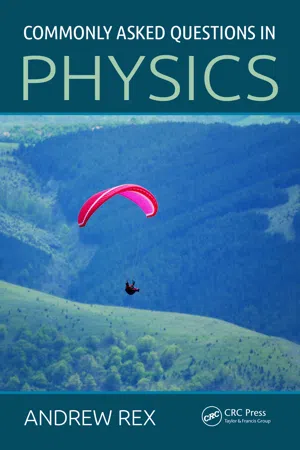
This is a test
- 256 pages
- English
- ePUB (mobile friendly)
- Available on iOS & Android
eBook - ePub
Commonly Asked Questions in Physics
Book details
Book preview
Table of contents
Citations
About This Book
In the 300 years since Newton's seminal work, physics has explained many things that used to be mysterious. Particularly in the last century, physics has addressed a range of questions, from the smallest fundamental particles to the large-scale structure and history of the entire universe. But there are always more questions.Suitable for a wide aud
Frequently asked questions
At the moment all of our mobile-responsive ePub books are available to download via the app. Most of our PDFs are also available to download and we're working on making the final remaining ones downloadable now. Learn more here.
Both plans give you full access to the library and all of Perlego’s features. The only differences are the price and subscription period: With the annual plan you’ll save around 30% compared to 12 months on the monthly plan.
We are an online textbook subscription service, where you can get access to an entire online library for less than the price of a single book per month. With over 1 million books across 1000+ topics, we’ve got you covered! Learn more here.
Look out for the read-aloud symbol on your next book to see if you can listen to it. The read-aloud tool reads text aloud for you, highlighting the text as it is being read. You can pause it, speed it up and slow it down. Learn more here.
Yes, you can access Commonly Asked Questions in Physics by Andrew Rex in PDF and/or ePUB format, as well as other popular books in Physical Sciences & Physics. We have over one million books available in our catalogue for you to explore.
1
Classical Mechanics
All around us we see bodies in motion, and a big part of physics concerns how and why things move the way they do. Quite a lot of what you see can be explained by classical mechanics, a branch of physics that goes back to the seventeenth century. Many of the basic concepts and ideas came from Isaac Newton (1642–1727), so physicists often use the term Newtonian mechanics interchangeably with classical mechanics. Since the days of Newton, the field has been revised and expanded to include new concepts, particularly energy, which along with better computational methods has improved the power of classical mechanics to explain what we see and to make predictions about how physical systems will behave. Perhaps surprisingly, much of the world around you can be explained using relatively few simple rules and concepts.
What is Physics?

Classical mechanics is just one part of the much larger subject that we call physics. Broadly speaking, physics is the study of the whole universe around us, ranging from the largest structures—galaxies and groups of galaxies—to the smallest subatomic particles, and everything in between. One concept central to physics is the study of forces, which govern the interactions of objects and particles with one another. Another key concept is energy, which allows us to analyze many key processes and transformations. Both energy and force are useful in studying how things move in space and time.
Many of the key concepts in physics, including force and energy, had their roots in early classical mechanics. In that context, they’re still useful today to help us understand the motion of some everyday things, from falling balls to simple machines. However, these old concepts are now applied in ways that go far beyond classical mechanics. For example, energy is an essential concept in quantum mechanics, where new approaches have helped us to understand processes in atoms and nuclei that classical mechanics can’t explain. And in the last century, physicists have identified new forces (called the strong and weak forces) that act only between subatomic particles over extremely short ranges. The number of topics and applications included in the study of physics has grown considerably since the time of Newton, but we still find classical mechanics useful in a variety of settings.
What Is the SI System of Units?

Sometimes people associate physics only with big ideas—gravity, nuclear energy, atoms and particles, and so on. But none of these ideas would be meaningful if we couldn’t measure and quantify the phenomena we see. Scientists generally use the SI system of units (from the French système international d’unités) for measurement. The SI system gives us a sensible common language for recoding measurements and for doing computations.
The three SI units that serve as the basis for classical mechanics are the meter (for length), kilogram (for mass), and second (for time). Measurements and computations are normally reported using the abbreviations m, kg, and s, respectively, as in a length of 3.2 m or a mass of 56 kg.
To avoid long strings of zeroes at the end of a number or after a decimal point, we use scientific notation, in which a measured or computed quantity is expressed as a number multiplied by a power of 10. For example, Earth’s mass is about 5.97 × 1024 kg, and the electron’s mass is 9.11 × 10−31 kg. By convention, quantities are normally reported with a single number to the left of the decimal point.
SI prefixes can be used as an alternative to powers of 10. Most people are familiar with using centimeters (cm) and millimeters (mm) for measuring leng...
Table of contents
- Preface
- Acknowledgments
- About the Author
- Chapter 1 - Classical Mechanics
- Chapter 2 - Electromagnetism and Electronics
- Chapter 3 - Solids and Fluids
- Chapter 4 - Quantum Mechanics
- Chapter 5 - Light and Optics
- Chapter 6 - Thermodynamics
- Chapter 7 - Atoms and Nuclei
- Chapter 8 - Fundamental Particles and Forces
- Chapter 9 - Relativity
- Chapter 10 - Astrophysics and Cosmology